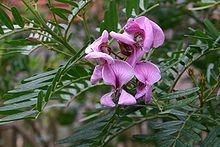|
Podalyrieae Benth. è una tribù di piante appartenente alla famiglia delle Fabacee.[1][2]
Descrizione
Distribuzione e habitat
La tribù delle Podalyrieae fece la sua comparsa durante l'Olocene, 30.5 ± 2.6 milioni di anni fa nel fynbos sudafricano, il quale costituisce ancora oggi pressappoco il suo areale[3][4] .
Ecologia
Tutti i membri della tribù esibiscono strategie di resistenza agli incendi[5].
Molte specie vengono impollinate dagli insetti, in particolare dagli appartenenti al genere Xylocopa[6], altre da roditori o da uccelli della famiglia Nectariniidae[3].
Tassonomia
Le Podalyrieae fanno parte del ‘clade genistoide’, un raggruppamento monofiletico che include anche Crotalarieae, Genisteae, Thermopsideae, Brongniartieae, Euchresteae e Sophoreae s.s.[7][8].
La tribù comprende i seguenti generi[9]:
Note
- ^ (EN) Cardoso D, Pennington RT, de Queiroz LP, Boatwright JS, Van Wyk BE, Wojciechowski MF, Lavin M, Reconstructing the deep-branching relationships of the papilionoid legumes, in S Afr J Bot, vol. 89, 2013, pp. 58–75, DOI:10.1016/j.sajb.2013.05.001.
- ^ (EN) Wojciechowski MF, Towards a new classification of Leguminosae: Naming clades using non-Linnaean phylogenetic nomenclature, in S Afr J Bot, vol. 89, 2013, pp. 85–93, DOI:10.1016/j.sajb.2013.06.017.
- ^ a b (EN) Boatwright JS, Savolainen V, Van Wyk B-E, Schutte-Vlok AL, Forest F e Van der Bank M, Systematic position of the anomalous genus Cadia and the phylogeny of the tribe Podalyrieae (Fabaceae), in Syst Bot, vol. 33, n. 1, 2008, pp. 133–147, DOI:10.1600/036364408783887500.
- ^ (EN) Linder HP, The radiation of the Cape flora, southern Africa, in Biol Rev Camb Philos Soc, vol. 78, n. 4, 2003, pp. 597–638, DOI:10.1017/S1464793103006171, PMID 14700393.
- ^ (EN) Schutte AL, Vlok JH, Van Wyk BE, Fire-survival strategy—a character of taxonomic, ecological and evolutionary importance in fynbos legumes, in Pl Syst Evol, vol. 195, 3–4, 1995, pp. 243–259, DOI:10.1007/BF00989299.
- ^ (EN) Schutte AL, Van Wyk BE, Schutte-Vlok AL, Forest F. e Van der Bank M., Evolutionary relationships in the Podalyrieae and Liparieae (Fabaceae) based on morphological, cytological, and chemical evidence, in Pl Syst Evol, vol. 209, 1–2, 1998, pp. 1–31, DOI:10.1007/BF00991521.
- ^ (EN) Pennington, R.T., Klitgaard, B.B., Ireland, H. & Lavin, M., New insights into floral evolution of basal Papilionoideae from molecular phylogenies, in Advances in Legume Systematics, vol. 9, 2000, pp. 233-248.
- ^ (EN) Crisp, M.D., Gilmore, S. & Van Wyk, B-E., Molecular phylogeny of the genistoid tribes of papilionoid legumes, in Advances in Legume Systematics, vol. 9, 2000, pp. 249-276.
- ^ (EN) Boatwright, J.S.; Savolainen, V.; van Wyk, B.-E.; Lise Schutte-Vlok, A.; Forest, F.; van der Bank, M., Systematic position of the anomalous genus Cadia and the phylogeny of the Tribe Podalyrieae (Fabaceae), in Systematic Botany, vol. 33, 2008, pp. 133-147.
Altri progetti
|

